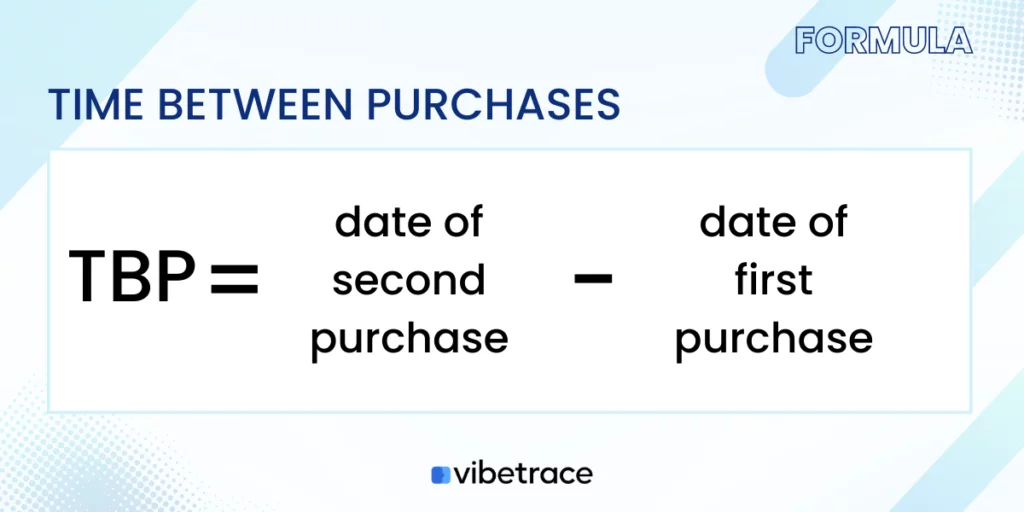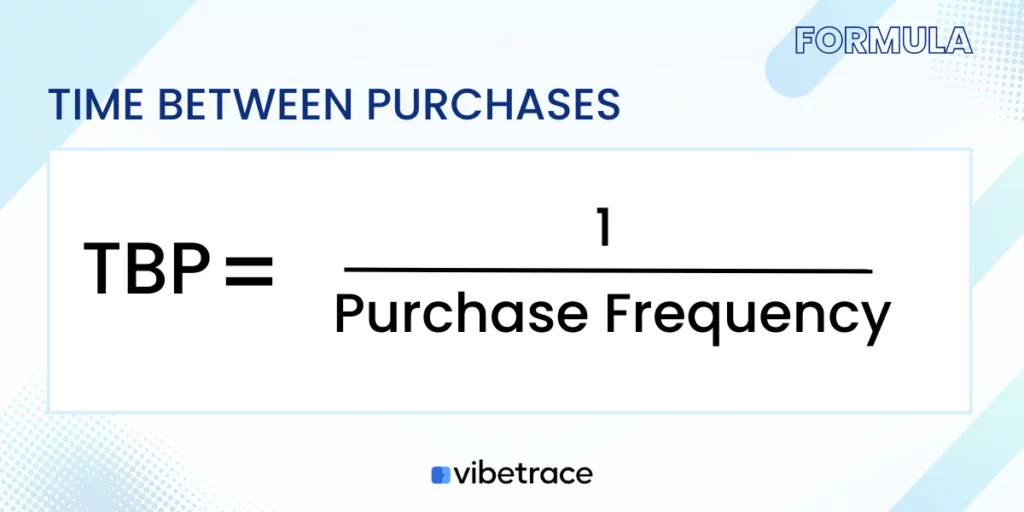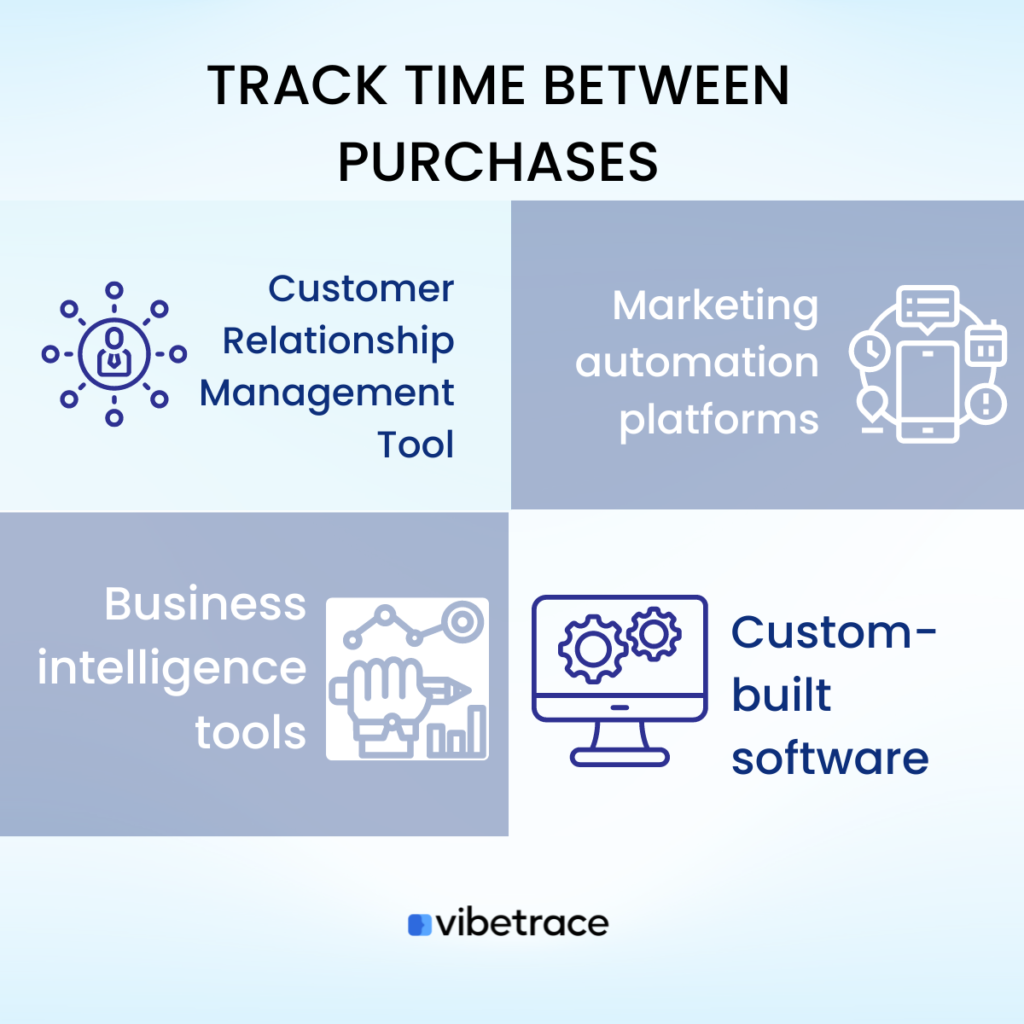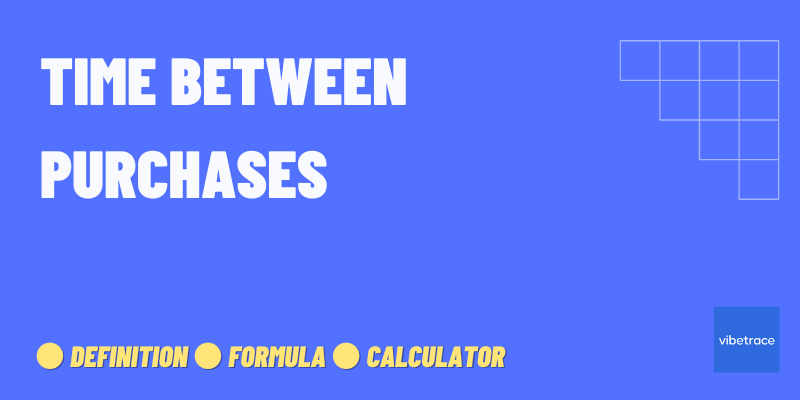Time between purchases is a metric that shows the customer journey as they make their second purchase.
Businesses often perform best when customers become loyal and repeat customers who purchase and look forward to new offerings. They can either help a business grow or lose potential revenue.
Therefore, it is best to use a key performance indicator (KPI) that is as valuable as the acquisition of new customers, as it measures the frequency of customers repeating their purchases of your offerings.
What is Time Between Purchases?
Definition of Time Between Purchases
Time Between Purchases (TBP) is a metric that measures the time elapsed between a customer’s first and second purchase, or between subsequent purchases thereafter.
This metric provides you with insight into your customer behavior and the effectiveness of your marketing and customer retention strategies.
In simple terms, this metric can help determine whether customers are satisfied with the offerings or products they received from their initial purchase. You can calculate the optimal time to encourage customers to make subsequent purchases.
Using this metric can help you to determine if your business is successfully retaining customers and if its marketing efforts are effective at encouraging repeat purchases.
Additionally, businesses can use TBP to identify customer segments with different purchasing behaviors and tailor their marketing and retention strategies accordingly. For example, if a segment of customers has a shorter TBP than others, a business may want to focus more resources on retaining those customers and encouraging them to make more frequent purchases.
Time Between Purchases Formula

This formula calculates the number of days, weeks, or months that have passed between the customer’s first and second purchase.
TBP can also be calculated for subsequent purchases, using the same formula but using the date of the previous purchase instead of the first purchase.
For example, if a customer made their first purchase on January 1st and their second purchase on February 15th, the TBP would be calculated as:
TBP = February 15th – January 1st = 45 days
You can use this formula to calculate the average TBP for all customers or for specific customer segments, which can help inform marketing and customer retention strategies.
Alternatively, you may also use purchase frequency to calculate the Time Between Purchases (TBP):

This formula calculates the average time between purchases based on the number of times a customer makes a purchase within a given period.
For example, if a customer makes 3 purchases within a 6-month period, the Purchase Frequency would be calculated as:
Purchase Frequency = Number of Purchases / Time Period
Example: 15 / 30 = 0.5 purchases per month
Using this Purchase Frequency, the TBP can be calculated as:
TBP = 1 / Purchase Frequency = 1 / 0.5 = 2 months
This formula can be used to estimate the average TBP for customers who make multiple purchases within a given period, such as a month or a quarter.
Time Between Purchases by Industry
The average Time Between Purchases (TBP) varies by industry, as customer behavior and purchasing patterns can differ based on the type of product or service being offered. Here are some examples of TBP by industry:
E-commerce: In the e-commerce industry, the average TBP is around 90 days. This is because customers tend to make purchases less frequently but in larger volumes.
Grocery: In the grocery industry, the average TBP is around 7-14 days. This is because grocery items are generally consumable and need to be replenished frequently.
Fashion: In the fashion industry, the average TBP is around 60-90 days. This is because customers tend to purchase new clothing items each season or as their personal style evolves.
Beauty: In the beauty industry, the average TBP is around 30-60 days. This is because beauty products tend to have a shorter lifespan and need to be replenished more frequently.
Electronics: In the electronics industry, the average TBP is around 1-2 years. This is because electronic devices tend to have a longer lifespan and are not replaced as frequently as other types of products.
These are just a few examples based on common information as there is still limited statistics that shows time between purchases of industries. TBP can vary widely depending on the specific product or service being offered.
Understanding the use of TBP can help you better understand your customer’s behavior and tailor your marketing and retention strategies accordingly.
Do you like this article?
Join our CX for Retail dedicated newsletter!

Stay connected to what’s really important to optimize your digital revenues.
By clicking the button, you accept our Terms & Conditions. Also you will need to confirm your email address.
How to track Time Between Purchases?
There are various tools and methods available for tracking Time Between Purchases (TBP), depending on your business and the data available. Here are some common methods and tools for tracking TBP:

Customer Relationship Management (CRM) software: Many CRM software systems have built-in analytics and reporting features that can track TBP and other key performance indicators (KPIs) related to customer behavior. By tracking TBP over time, you can identify trends and adjust your strategies accordingly.
Marketing automation platforms: Marketing automation platforms such as Vibetrace, can track TBP and other customer behavior metrics through website tracking and email campaigns.
Business intelligence tools: You can use business intelligence tools such as Tableau or Power BI to analyze customer data and track TBP. These tools can help you identify patterns and trends in customer behavior over time.
Custom-built software: You may choose to develop your own software or tools to track TBP and other customer metrics. This approach allows for more customization and flexibility but may require additional resources and expertise.
Tracking TBP can provide you with valuable insights into customer behavior and help optimize your marketing and retention strategies. By using one or more of these tools, you can gather and analyze the data you need to drive revenue growth and increase customer loyalty.
How often should you check Time Between Purchases?
The frequency at which you should check the Time Between Purchases (TBP) depends on the industry, customer behavior, and your business goals.
Generally, You should aim to check TBP on a regular basis to track changes in customer behavior over time and identify trends that may require adjustments to your marketing and retention strategies.
Weekly or Monthly: If your business is in the grocery industry may want to check TBP weekly or monthly to monitor changes in customer purchasing patterns and adjust inventory levels accordingly.
Quarterly or Annually: if your business is in the electronics industry may check TBP quarterly or annually, as customers tend to make purchases less frequently.
It’s also important to note that TBP should be used in conjunction with other customer behavior metrics, such as customer lifetime value (CLV), customer retention rate, and customer acquisition cost (CAC).
Time Between Purchases Calculator
Do you want to calculate your time between purchases? Use our simple calculator below.
Simple Time between Purchases Calculator
Number of days:
Purchase Frequency:
Time between Purchases
= ?
Time Between Purchases Optimization
Optimizing Time Between Purchases (TBP) involves implementing strategies that encourage your customers to make repeat purchases at shorter intervals. Here are some tips for optimizing TBP:
Personalized recommendations: You can use customer data and machine learning algorithms to offer personalized recommendations based on your customers’ past purchases.
Loyalty programs: Loyalty programs can incentivize customers to make repeat purchases by offering rewards, such as discounts or exclusive access to new products or services.
Email campaigns: Email campaigns can be a powerful tool for nurturing customer relationships and encouraging repeat purchases. Learn more about email marketing and optimize your TBP using Vibetrace marketing automation features.
Customer service: Providing excellent customer service can help build trust and loyalty with customers, which can encourage them to make repeat purchases.
Upselling and cross-selling: By offering customers upgrades or complementary products or services, you can encourage your customers to make additional purchases at shorter intervals. This approach can be particularly effective if your business has a diverse range of products or services.
Important Things about Time Between Purchases
The time between purchases, also known as the purchase cycle, is an important metric in marketing and retail. Here are some important things to know about the time between purchases:
Varies by industry and product: The time between purchases can vary greatly depending on the industry and product. For example, a consumer may purchase a new car every few years, while they may purchase groceries every week.
Indicate customer loyalty: A shorter time between purchases may indicate a higher level of customer loyalty to a brand or product. If a customer is making repeat purchases in a short period of time, it may suggest that they are satisfied with your product and are likely to continue buying it.
Help with inventory management: Knowing the average time between purchases can help you manage your inventory. If a product has a short purchase cycle, you may need to keep more inventory on hand to ensure you can meet demand.
Influenced by marketing: Marketing campaigns can influence the time between purchases. For example, a sale or promotion may encourage customers to purchase a product sooner than they otherwise would have.
Predict future sales: Analyzing the time between purchases can help you predict future sales and revenue. By understanding how often customers make purchases and how much they typically spend, you can forecast your sales and plan accordingly.
Overall, the time between purchases is an important metric for your business to track and analyze. It can help with inventory management and sales forecasting.
Metrics related to Time Between Purchases
There are several metrics related to Time Between Purchases (TBP) that you can use to gain insights into customer behavior and optimize your marketing and retention strategies. Here are some examples:
Customer Lifetime Value
The estimated total value of a customer to a business over the course of their lifetime
Purchase Frequency
The measure of how often customers make purchases from a business.
Average Order Value
Repeat Purchase Rate
The percentage of customers who make more than one purchase from your website.
Churn Rate
The percentage of customers who stop using a product or service over a given time period.
Time on Site
The amount of time visitors spends on your website.
Vibetrace can help your business reduce the time between purchases by leveraging customer data to create personalized email marketing campaigns and experiences.
Vibetrace can use customer data and predictive analytics to identify customers who are likely to make another purchase soon. It can send targeted marketing messages that encourage them to make a purchase, reducing the time between purchases.
These campaigns can include special offers or promotions to incentivize customers to make a purchase and reduce the time between purchases.

